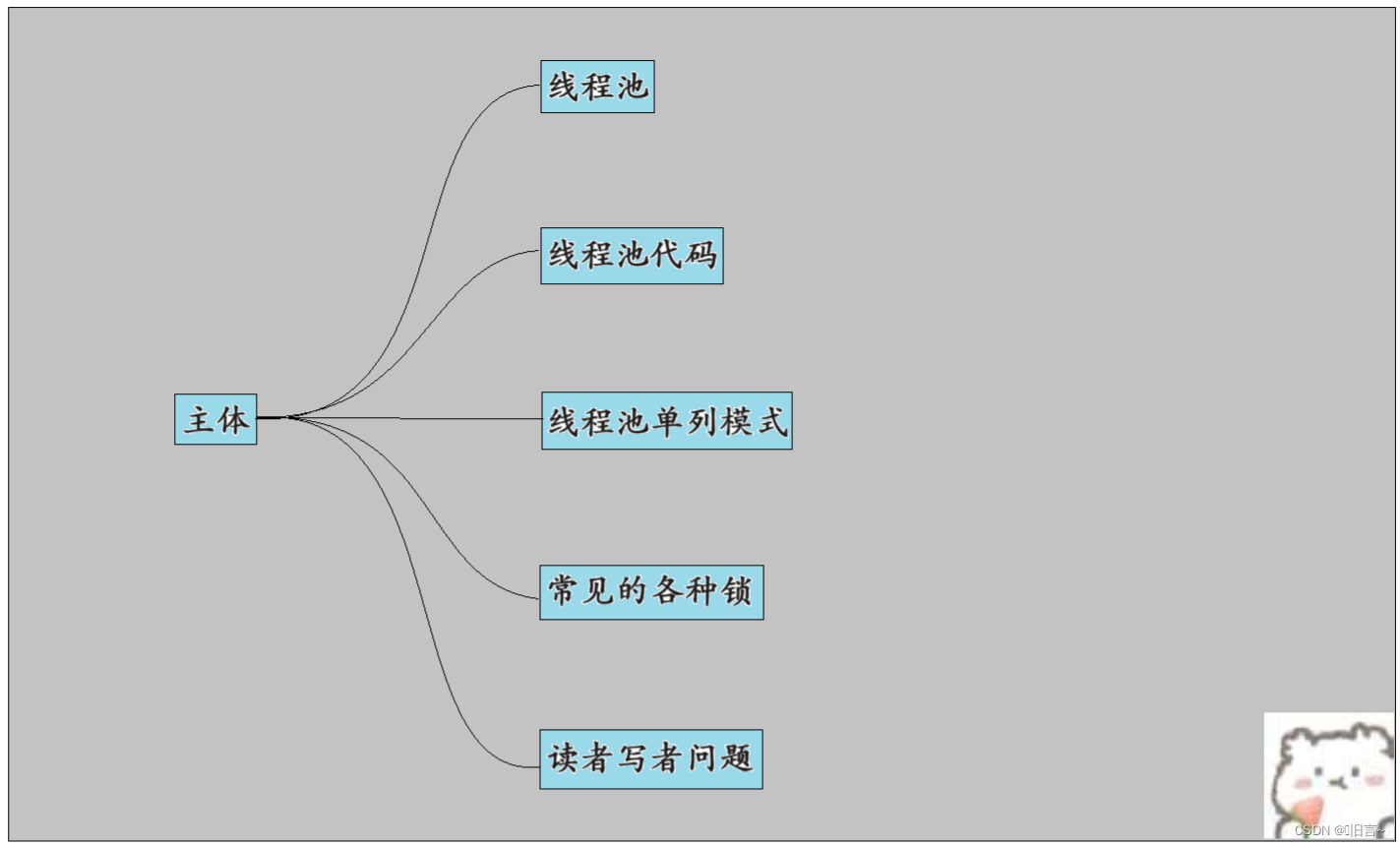【Linux】线程池|单例模式|STL、智能指针线程安全|读者写者问题
> 作者:დ旧言~
> 座右铭:松树千年终是朽,槿花一日自为荣。
> 目标:理解【Linux】线程池|单例模式|STL、智能指针线程安全|读者写者问题。
> 毒鸡汤:有些事情,总是不明白,所以我不会坚持。早安!
> 专栏选自:Linux初阶
> 望小伙伴们点赞👍收藏✨加关注哟💕💕
🌟前言
今天是Linux的最后一片博客,相信大家已经坚持下来了,还是那句话 " 学,然后知不足 "!!!
⭐主体
学习【Linux】线程池|单例模式|STL、智能指针线程安全|读者写者问题咱们按照下面的图解:
🌙 线程池
线程概念:
一种线程使用模式。线程过多会带来调度开销,进而影响缓存局部性和整体性能。而线程池维护着多个线程,等待着监督管理者分配可并发执行的任务。这避免了在处理短时间任务时创建与销毁线程的代价。线程池不仅能够保证内核的充分利用,还能防止过分调度。可用线程数量应该取决于可用的并发处理器、处理器内核、内存、网络sockets等的数量。
线程池的应用场景:
- 需要大量的线程来完成任务,且完成任务的时间比较短。 WEB服务器完成网页请求这样的任务,使用线程池技术是非常合适的。因为单个任务小,而任务数量巨大,你可以想象一个热门网站的点击次数。 但对于长时间的任务,比如一个Telnet连接请求,线程池的优点就不明显了。因为Telnet会话时间比线程的创建时间大多了。
- 对性能要求苛刻的应用,比如要求服务器迅速响应客户请求。
- 接受突发性的大量请求,但不至于使服务器因此产生大量线程的应用。突发性大量客户请求,在没有线程池情况下,将产生大量线程,虽然理论上大部分操作系统线程数目最大值不是问题,短时间内产生大量线程可能使内存到达极限,出现错误。
线程池示例:
- 创建固定数量线程池,循环从任务队列中获取任务对象。
- 获取到任务对象后,执行任务对象中的任务接口。
🌙 线程池代码
Thread.hpp的简单封装线程,下面我们进行简单的验证:
- Thread类主要成员变量是线程名,函数,线程参数,参数ID以及对应编号。
- Thread类提供了一个无参构造,完成对成员变量name的赋值。
- 同时,对外主要提供了start接口和join接口,对于join接口就是线程等待,而对于start接口就是创建线程的接口,在外部如果调用的话我们需要传入对应的函数以及线程对应的参数。
代码如下:
pragma once #include #include #include #include #include #include namespace ThreadNs { typedef std::function func_t; const int num = 1024; class Thread { private: static void *start_routine(void *args) { Thread *td = static_cast(args); return td->callback(); } public: Thread() { char buffer[num]; snprintf(buffer, sizeof buffer, "thread-%d", threadnum++); _name = buffer; } void start(func_t func, void *args) { _func = func; _args = args; int n = pthread_create(&_tid, nullptr, start_routine, this); } void join() { int n = pthread_join(_tid, nullptr); assert(n == 0); (void)n; } std::string threadname() { return _name; } void *callback() { return _func(_args); } ~Thread() { } private: std::string _name; void *_args; func_t _func; pthread_t _tid; static int threadnum; }; int Thread::threadnum = 1; }对于任务队列,可以由多个线程进行访问,我们就需要加锁保护了,把之前写过的锁的小组件引入进来:
LockGuard.hpp:
#include #include class Mutex { public: Mutex(pthread_mutex_t*lock_p=nullptr) :lock_p_(lock_p) {} void lock() { if(lock_p_) pthread_mutex_lock(lock_p_); } void unlock() { if(lock_p_) pthread_mutex_unlock(lock_p_); } ~Mutex() {} private: pthread_mutex_t * lock_p_; }; class LockGuard { public: LockGuard(pthread_mutex_t*mutex) :mutex_(mutex) { mutex_.lock(); } ~LockGuard() { mutex_.unlock(); } private: Mutex mutex_; };线程池代码如下:创建一批线程时,我们需要实现线程的运行函数static void*handlerTask,之所以是静态的,是因为我们要把这个运行函数传递给Thread类中的func_,不能有this指针,所以是静态成员函数。而没有this指针,我们无法访问ThreadPool里面的成员变量,所以需要封装接口供其调用。
ThreadPool.hpp:
#pragma once #include "Thread.hpp" #include "LockGuard.hpp" #include #include #include #include #include using namespace ThreadNs; const int gnum = 3; template class ThreadPool; template class ThreadData { public: ThreadPool *threadpool; std::string name; public: ThreadData(ThreadPool *tp, const std::string &n) : threadpool(tp), name(n) { } }; template class ThreadPool { private: static void *handlerTask(void *args) { ThreadData *td = (ThreadData *)args; ThreadPool *threadpool = static_cast(args); while (true) { T t; { LockGuard lockguard(td->threadpool->mutex()); while(td->threadpool->isQueueEmpty()) { td->threadpool->threadWait(); } t = td->threadpool->pop(); } std::cout name






